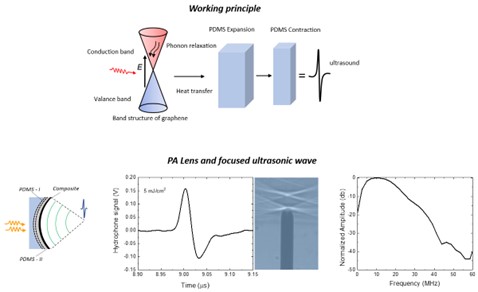Researchers from the Laboratory for Laser Techniques (LASTEH) in cooperation with researchers from Jožef Stefan Institute developed a graphene-Polydimethylsiloxane (PDMS) composite on a flexible substrate for the photoacoustic generation of ultrasounds. They investigated in detail the photoacoustic (PA) response of the film when irradiated with a nanosecond pulsed laser, for different graphene concentrations and thicknesses. The results of the research were published in the journal Photoacoustics (IF=9,656).
The results show a PA signal amplitude that achieves 11MPa and linearly depends on the laser fluence. The onset of saturation of the PA signal at high laser fluence can be interpreted as variations of the Grüneisen parameter with increasing temperature. Further, they demonstrated that a freestanding FLG composite can easily be embedded in an optical lens to launch spatially and temporally confined high amplitude ultrasonic wave (> 40 MPa) with a central frequency of 11 MHz and − 6 dB-bandwidth of 21.5 MHz. The time-dependent imaging of the process reveals the formation of cavitation microbubbles in water and in agar phantom.

The manuscript elucidates the fundamental features relevant to biomedical applications and the photoacoustic parameters of the composite important to assess device fabrication. Possible implications of using the flexible photoacoustic composite in biomedical and biochemical applications are also discussed.
Link to the article: https://doi.org/10.1016/j.pacs.2022.100413